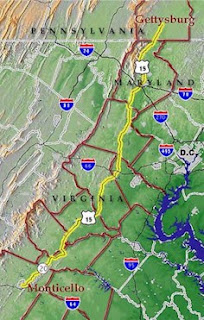I find myself getting sucked into the controversy over the Journey Through Hallowed Ground more than I anticipated. A group of hard-core property rights groups has rallied against the federal legislation to designate the 175-mile Journey region as a National Heritage Area. I’d ignored these guys until now because I deemed their views not only as fringe but inaccurate and irrelevant.
But there is no ignoring them any more. Ron Utt, a fellow with the Heritage Foundation, and a man whose views I respect (I’ve published five of his columns on Bacon’s Rebellion over the years) has published a paper, “Another Federal Assault on Property Rights: The Journey Through Hallowed Ground National Heritage Area Act.” A scholar of Utt’s stature, working for a credible organization like Heritage, gives gravitas to the fringe groups that they don’t deserve. Sadly, Utt gets the story horribly wrong.
In a nutshell, Utt views the JTHG as a scheme for strengthening the hand of the landed elite in Virginia’s northern piedmont in their aim to restrict property rights and curtail the development that threatens their lifestyles. In my column this week, “Missing the Point,” I argue (a) that the Journey is a grassroots movement, not an artiface of the elite, (b) that it is dedicated to exactly what it says it is, the preservation of history, and (c) that there is no evidence, only inference and innuendo, to support Utt’s view that the Journey represents a threat to property rights.
There’s a larger issue at stake, which I had hoped to develop in a separate column this week, but lacked the time. Quoting myself:
The challenge, as I see it, is analogous to one that Newt Gingrich articulated in his most recent “Winning the Future” newsletter, in which he outlined the case for “green conservatism.” The conservation and environmental movements have been hijacked by big-government, command-and-control liberalism, Gingrich argues, in large measure because conservatives have spent too much energy criticizing the flaws in liberal ideas and not enough proposing their own solutions.
The Journey Through Hallowed Ground represents a grassroots response pushing market solutions to the challenge of historic preservation. Philosophically, the Journey is consistent with conservative values. It should be held up as a model for emulation. Conservatives are very short-sighted to malign and mischaracterize it.


Leave a Reply
You must be logged in to post a comment.